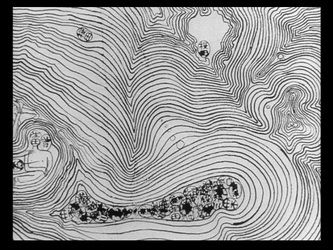Remember, your images are ABOVE your name.
|
x |
|
|
1. |
|
|
|
|
|
Jennifer Beggs
In 1964 the director had a choice as to whether or not to use colour or B/W. What do you think motivated him to use B/W? (do not answer the next question). If it were filmed today, do you think the same choice would be made? Why or why not?
In the movie Woman in the Dunes the director’s intentions and vision of the film most likely included a portrayal of a bland, mild tone of the narrative. Presenting the movie in black and white sets the appropriate mood for the movie. Unlike 300, for example, there are no intense action scenes that are meant to keep the audience on the edge of their seats. Colour would help create the tense, vibrant atmosphere; however it is not needed in this case. The lack of colour helps highlight this bland tone of the movie. Living in the sand dunes isn’t very uplifting or exciting, and the tone of the movie needs to portray this in order to capture the viewers and immerse them into the atmosphere of the film.
When the man and the woman are in the hut, the black and white effect adds to the atmosphere of the scene. There is not much “colour” in the situation and the black and white film creates a bland mood, similar to the essence of the situation. Colour would not add anything to the effect of the film in this regard. Black and white footage has a very raw feeling. The circumstance of the couple living in the dunes is very real and direct. There is little “sugar-coating” or epic music to suggest excitement and emotion. The movie portrays the reality of their situation. It is what it is; whereas 300 has a lot of added effects with colour, saturation, colour highlights to bright up the tension and exhilaration of the film. There are no objects or characters that are emphasized with colour. The emphasis is more subtle; more like a “calm drama.” In the scene where the man is shovelling the sand, the black and white effect stresses the fact the dreary feeling that the man is experiencing from living in the dunes.
Light is often used to put emphasis on important elements. The scenes are stripped down to shapes and forms (no colour), therefore when light is introduced into a scene it makes a huge impact. In the scenes showing the man opening the door and light fills the room, the brightness is emphasized even more from the film being in black and white. Colour may tend to wash out the effect of light from the outside pouring into their dwelling. This light is important to symbolize what is outside, and suggesting there is something outside worth searching for. Because the black and white effects is so important to the impression of the film, I believe if the movie were to be released in the present day, it would be in black and white. |
|
|
2.
|
|
|
|
|
|
Jaliya Fonseka
How would the film be different if it were shot in colour? (do not answer the question above). If it were filmed today, do you think the same choice would be made? Why or why not?
Woman in the Dunes, having been filmed in a desert setting, if filmed in colour would have the common brown tone prevalent throughout its scenes. This would be seen in the desert sand and also the wooden house engulfed in the sand. As this would create a very similar colour scheme it would be interesting to see what the director would paint the colours of the clothes worn by the characters in the movie. As this would either cause them to stand out or blend in with the rest of the brown tones. Thus, if filmed in colour, much more attention would be put forth in the deciding of clothes, shoes and other minor elements that would play a role in the depiction of the film, which otherwise would not have been regarded in the B&W film.
After watching the B&W film, as a viewer, we are more dependent on and are more sensitive to elements such as lighting. Thus, if shot in colour we would rely less on the use of lighting to guide us or attract our focus. We would look to the use of colour to give us certain hints or guide our eyes through the narrative.
The use of lighting in the B&W film is seen in the scene as the man enters the sandpit. As he struggles to find his way, the viewer is also limited as to what they can see. The use of minimal lighting here evokes the feeling of struggle and frustration as the viewer is almost finding their way around as the character is. In contrast, if shot in colour, regardless of how much lighting is shone on the scene the viewer would be able to contrast certain things such as the character from the background, and the house from the sandpit.
Another instance of this is when the woman first begins to shovel the sand and the man approaches her. As a playful act the woman begins to run around the man in the darkness, using her adapted eyes to push him as he searches for her helplessly. When seen in the man's point of view, darkness overwhelms any sense of direction and when the woman appears, it is very sudden and unexpected. Again, if shot in colour there would be more difficulty than not in trying to create the effect of being lost in the darkness as colours would be easily seen.
As the movie progresses and the man and woman are trapped in the dark poorly lit house, as a viewer we begin to appreciate the sense of human existence. This is because the black and white film portrays everything else as static or dead and we are only able to relate to the two moving figures. If colour was used in these scenes there would be a definite lack of appreciation towards the two people as the colours of elements such as the burning lamp or cups and other items would capture and entertain the viewer.
The dark nature of the B&W film also evoked a feeling of claustrophobia leaving the viewer to experience the discomfort felt by the characters in the film. This effect worked well with the b&w as it enhanced flat two dimensional feeling of space. It also raised the feeling of being trapped and exaggerated the feeling of being constantly covered in sand as the darkness induced the feeling of being dirty.
If filmed today, there would have to be a specific planned reason for Woman in the Dunes NOT to be shot in colour. This is due to the difficulty to shoot in b&w in a world where colour film is now seen as a standard and much more technologically advanced filming methods are emerging.
The decision to use b&w presently would have to be instigated by the narrative of the film and somehow convince its creators that black and white is essential. Otherwise, there would be no need for anyone at this day and age to film in b&w. Although the movies success is somewhat depended upon it being filmed in b&w, the current filming industry may see more opportunity for a greater "effect" using colour and other newer technologies.
|
|
|
3. |
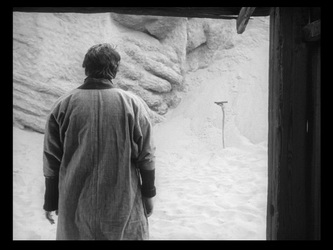 |
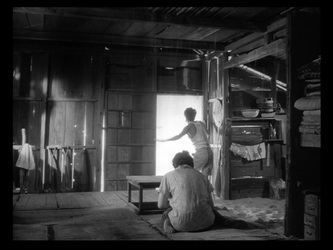 |
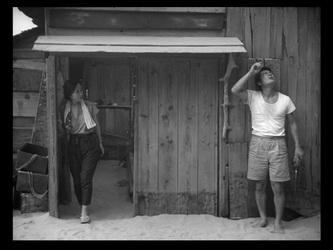 |
|
|
Miles Gertler
The main doorway and window of the house are used as a threshold for the action of the story. Discuss how the separation of interior vs exterior works as a device in the film, with the openings as passage.
In Woman in the Dunes the symbol of the threshold is distorted and ambiguous. Traditionally it is a representation of passage from interior to exterior, shelter to exposure, or captivity to freedom. In certain Japanese festivals grains are thrown from the threshold of the house to delineate transition from the potentially dangerous outside world to the protective realm of the hearth. Here though, its role is less clear. The sand walls of the pit around the house make it as much a room as the spaces within. When the sand threatens to collapse the roof of the house, its two occupants can't agree on whether to run outside or stay in. And it is the scene for multiple power transitions; both the teacher and the woman take turns as hostage inside of its screen-like walls.
The threshold is only as strong symbolically as the contrast it bridges. The apparent lack of contrast renders it ambiguously: as perilously inert as those inside.
As a location of action in the film it is like a stage. In a theatre, the director must adapt to the static relationship of viewer to set. This means a single stage must change constantly to portray different scenes. In a film the director has the luxury of moving around a set to film things as they are; a threshold can be shown from one side and later from another. In Woman in the Dunes, Hiroshi Teshigahara uses this to illustrate the lack of contrast insofar as the themes above are expressed, and this perplexity becomes a symptomatic condition experienced throughout by the captives as well.
The transitory nature of the house, and thus, the threshold, shifts constantly, much like the sand it is built on. This ambiguity is characteristic of the film and is explored through other devices: the desert often appears as water, the black and white footage creates a contrast that obscures detail, and the captive teacher seems to become a voluntary prisoner after his prolonged entrapment.
|
|
| x |
4. |
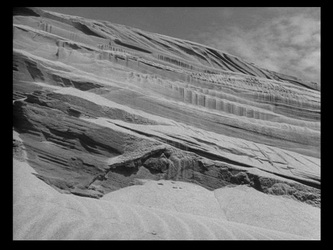 |
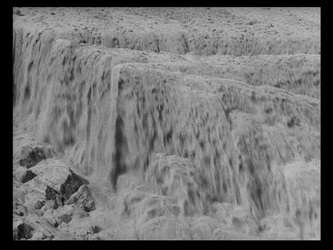 |
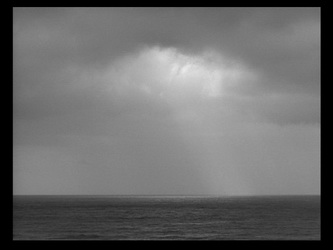 |
x |
|
Suzan Ibrahim
Comment on the effectiveness of the use of the grand landscapes of sand in the creation of the mood for the film. Discuss those where the sand is "still" and where the sand is "moving".
The film is composed of several kinds of shots representing and provoking different moods and emotions for the viewer as well as emphasizing the plot and story. In the film Woman in the Dunes, long static shots are generously used filming the condition of sand surrounding the dunes that the main characters are trapped within. The filming of sand not only creates a terrifying vision of the dangerous nature of it where it could possibly engulf the characters, but also questions its possibility of use for the characters to escape from. There were moments where the sand looked hard and still as rock, and the possibility to climb on it and out of the dunes created a hopeful mood, however, right after it broke into the fluidity of the sand and shots depicting the dune almost being swallowed up by the sand creates fear and despair.
The flow of the sand is often shown as flowing similar to liquid. The movie often refers back to the ocean that cannot be reached, where the ocean symbolizes freedom or an escape away from the current situation. But the sand is the main worry and context in which the main characters find themselves in. It is an engulfing power that acts as its own character, and in its own unpredictable way similar to the unrestricted water.
Then there are shots within the movie that serves as a relief from the regular "sand-landscape". These scenes are usually representative and an emphasis of the captivity the characters are under. The short shots of the sea creates a distance for the character, almost a sense of hopelessness where no help seem to emerge from the horizon. Other shots of the main character and his relation to the landscape are during his attempt of escape from the dune. He wanders and runs across an unfamiliar landscape that seems to have no character but a repetitive identity. Almost as a regular labyrinth without the walls. This again creates the mood of complete hopelessness and yet, its vast openness in contrast to the dangerous dunes form a sense of hope or an arrival point.
|
|
|
5. |
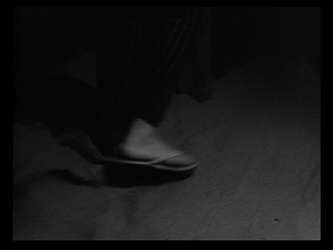 |
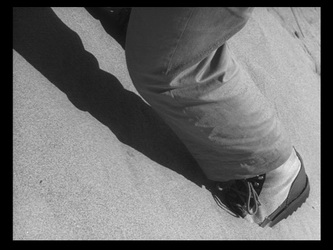 |
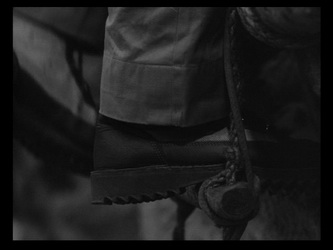 |
|
|
David McMurchy
Watch the film for the incidences of "feet" shots. Where are they used? Why do you think they have chosen this focus as an effect of cinematography that aids the narrative?
Anyone who has walked on a beach or through sand dunes understands the difficulty that sand creates in our motion. Each step taken is more laborious and requires extra effort against the constantly shifting sands.
Our protagonist finds himself a prisoner of both the villagers and the sands of the dunes. Although his confinement is caused by the villagers, it is sustained by the impossibilities of moving through sand dunes.
Our connection to the sand is felt clearly as we move, even if we don’t look at our feet and our steps. In the movie, feet shots were used to pit the characters against the landscape of sands. While there are numerous shots of sand cascading and shifting, these serve as more of a foreshadowing to the trials posed by the sands. By focusing on his feet as he moves we can contrast the amount of effort he expends attempting to escape with the very nature of sand itself, showing us the impossibility desire to leave.
The shot where he climbs down the ladder is particularly interesting as the difficulty with which he climbs down is very similar to the difficulties he’ll have attempting to climb out. A close up shot of his feet is used as they swing as he steps carefully down, as his descent is vital to his imprisonment. |
|
|
6. |
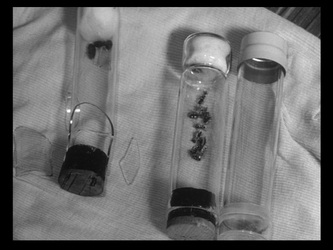 |
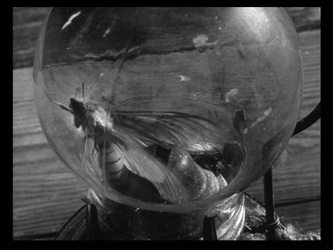 |
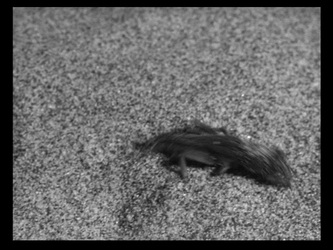 |
|
|
Benny Or
Discuss the visual and narrative inclusion of the insects in the story.
The role of insects in the story can be understood in several ways. The main character leaves to city life of Tokyo to collect insects in the desert as a hobby. In fact insects is the original reason why he ends up in his situation. As the story progresses and he becomes stranded in the sand dune, he forgets about the insects until we are reminded of them upon his discovery of the tiger beetle. Eventually however, near the end of the film he ultimately throws his collection of insects into the fire. This act can be seen as a metaphor for his departure from his previous life in Tokyo. The original cause for him to enter the desert, no longer mattered as he accepts his new reality. The insects can also be compared to the couple as surviving creatures in the wilderness as well. Scenes of insects burrowing in and out of sand directly correlates to the characters' struggle for survival as they dig themselves out of the sand dune day after day. The sequences depict their fragility and contrasts it with the insects' ability to adapt to the desert environment. There is also an irony found in that the character came to the desert to kill and collect these insects in jars and eventually he himself ends up captured in his own "jar" which is the sand dune and forced to try and survive. Lastly in the movie, the character is excited when he finally finds the Japanese Tiger Beetle. He describe it as the insect that he was most interested in acquiring on his quest. Tiger Beetles are known for their unique hunting technique. They live in burrows underground that run up to an meter deep. They hunt for their pray by waiting in their burrows in order to ambush other insects that pass above them, after which they drag their preys underground in order to devour them. This is a clear connection to the story of the film in that the character likewise is trapped in the sand dune and forced to struggle to survive.
|
|
|
7. |
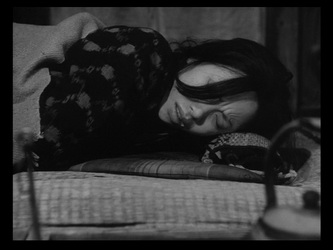 |
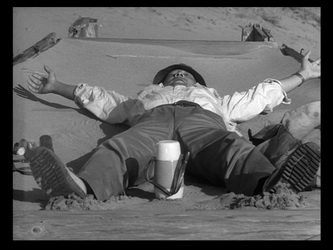 |
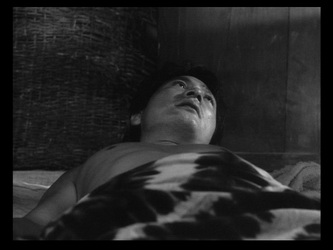 |
|
|
William Pentesco
Watch the film for extreme low angle shots. Why are they used? How do they propel or alter the narrative of the film?
Low angle shots are used in the film in a few different ways, one is as a closer view of the main characters, and the other is in a diminutive view from the foot of the pit or dune. These two branches both serve their own purpose throughout the film.
When we first meet Niki, we find out that he is a bug collector, searching for some undiscovered bug that can get his name in a book. As he is walking through the dunes there are many low angle shots used to either place him as an important character in the story, or show the distances and hardships he has to face while walking over the dunes. After Niki’s kidnapping this style of low angle shots then establishes the power that the men out of the pit have over the him, being captive in the pit. There is also a physical aspect to this type of shot, in that they had two choices for where to set up the camera easily, inside the pit or outside of the pit (likewise on top of the sand dune, or in the valleys). These shots do not propel the narrative of the film in any exceptional way, other then reinforcing the face that the main characters are ‘in’ the whole and the captives are ‘out’.
The other low angle shot is one that focus’s in on a subject. We are introduced to these shots as Niki discovers bugs in the beginning of the film. Then after getting kidnapped we have similar shots of Niki and the Women in the pit. They now become the specimen that is being studied. These shots allow for a deep reading of the character be it relaxation, contemplation, or fear. In the screenshot example of Niki lying in the shack, we see a contemplative face; we can assume he is in a struggle between fear of his captors, fear of the sand, and a defeat of being kidnapped and forced into a life of simple labor. The low angle shot provides to this medium a way to see how completely entranced he is in this contemplation.
|
|
|
8. |
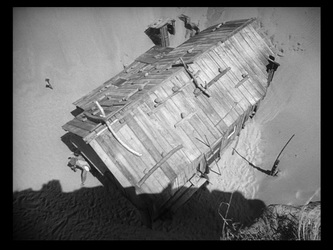 |
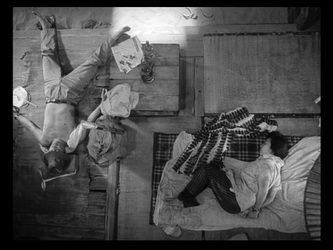 |
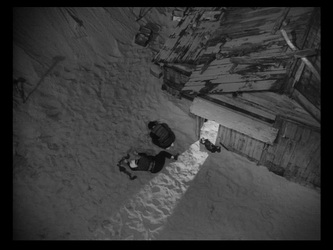 |
|
|
Emmanuelle Sainté
Watch the film for high angle views. Why are they used? How do they propel or alter the narrative of the film?
The use of high angle shots in the film Woman in the Dunes works to convey a certain atmosphere and thus propel the story. The film portrays the imprisonment of an entomologist and his coming to terms with a world that at first seems completely alien to him.
The first images that the audience view from a high angle, would be the sweeping landscapes created by the dunes. These images call into being a sense of isolation, of separation from the rest of the world. This is a landscape that is foreign to most people who live in the city, and therefore to most of the audience of this film, which has the effect of creating the idea of a world that is separate, and out of the ordinary, which presages the mood throughout the film.
An interesting series of shots that were done at high angles were that of the main character trying to escape from his place of captivity. The angle here serves to emphasize the sense of his being contained, and add to the feeling of his lack of power against the forces keeping him in place. The more he would attempt to climb, the more sand would be displaced as the walls would begin to cave in, and the more the audience would feel the futility of his trying to escape.
This was also evident in the scene following his request to his captors to let him go up to the surface once a day to go see the ocean. As they surround him, and look at him from above, taunting him to debase himself and reduce himself to little more than an animal, we can see him fighting a losing battle with his dignity, and succumbing to his circumstances in his acceptance that he had no power.
Certain high angle shots were used in the movie to emphasize the sense of disconnect between the house in the dunes and the outside world. For example, the shots of Jumpei and the woman, each lying immobile on their beds, taken from a perfect bird’s eye perspective, have an almost floating sensation to them, where the viewer is given the impression that they are completely and utterly alone in the world, and that there is nothing beyond the resolute silence of the dunes.
A high angle shot was also used to reveal the discovery of water in Jumpei’s crow trap. This discovery is important because it helps him make peace with his new world and his circumstances.
The high angle views are thus used throughout the film to place emphasis on the atmosphere created by each scene, which correlate to the development of the main character. |
|
|
9. |
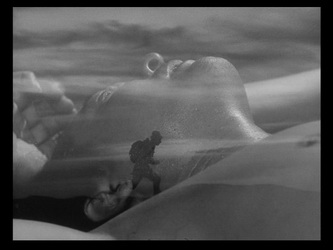 |
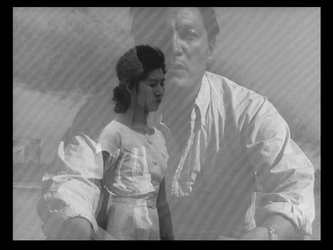 |
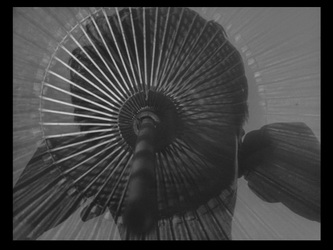 |
|
|
Tristan van Leur
Comment on the use of superposition to create the dreamlike sequences in the film. Do you think this method is still held as current or do you consider it dated? Is it effective for this particular film? How do these propel or alter the narrative of the film?
The superposition is used in Woman in the Dunes as a way to get into the protagonists thoughts. It allows the audience to understand what he is thinking, or dreaming, or wanting. The effect allows for the audience to feel the emotions and cravings that run through Jumpei’s mind. Superposition is one of the easier ways to convey to the audience that you are in the characters mind, as it creates a surreal atmosphere, while still having the context of the body and mind in focus.
The use of superposition to create dreamlike or thought sequences has become somewhat dated. With many new special effects, it becomes very possible to convey to the audience the surreal feel of a dream, without having to show the context of the person. In this particular instance though, the superposition was a necessity to downplay the importance of the dreams and to make them blend in and out of the film, making sure it was a secondary feature of the film.
The superposition shots do not necessarily drive the film, but rather they enhance the film. They make the audience understand Jumpei’s thoughts, but they would be able to understand his desperate entrapment without these scenes as well. They are a secondary component in the narrative, and their importance is one of mood and context, which is displayed in the careful and delicate manner in which they are blended into the film, rather than heavily emphasized.
|
|
|
10. |
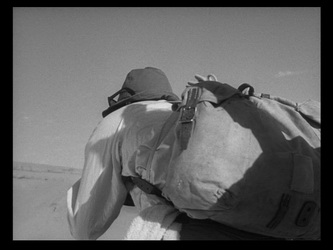 |
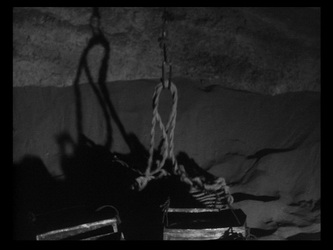 |
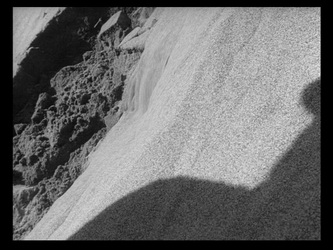 |
|
|
Benjamin Van Nostrand
Discuss how shadow is used as an effect in this film. Does the director do anything "more" with the use of shadow - alone or in combination with sound?
In black and white films especially, shadow plays an enormously important role in delineating space, subdividing the frame and providing natural framing for action taking place within the scene. As most of Woman In The Dunes takes place in the relatively dimensionless void of the sand pit, these shadows play a much more unusual and interesting role. As a background material, especially when shot on black and white film, sand becomes a sort of amorphous white noise. It has the same appearance at many different levels of zoom, tends to flow into smooth shapes without angles that might give some indication of its form, and scatters diffuse light extremely evenly. As such, without hard-edged shadows falling on it, sand is as blank a background as a green screen would be. Shadows become necessary to show the depth and dimension of the space in the sand pit, to give a sense of scale to individual shots, and break the monotony of a sand background.
Additionally, the hard shadows cast by the lamp in the interior shots create a sharp, angular geometric look which contrasts well with the amorphousness of the exterior and defines the close boundaries of the tight interior.
It would have been interesting to see some of the scenes shot with high-ASA film, and see what effect film grain would have on the appearance of the sand grain: perhaps if the patterns of the noise were regular enough, interesting interference patterns or Moiré patterns might emerge.
In terms of sound, the only audio comparison that comes to mind lies in the 'white noise' aspect of the sand. The sound of its movement in cascade is the audio analogue to its look on film; especially black and white film.
|
|
|
11. |
|
|
|
|
|
Shane Neill
Discuss the manipulation of the sound in the film. Listen carefully for instances where the natural sound of the scene has been stripped and replaced by the sounds of nature (wind for instance) or "musical" sounds. How does this propel the narrative? (It would be beneficial to compare Dunes to the 1965 film Alphaville by Jean Luc Godard).
Woman in the Dunes was one of four landmark collaborations between director Hiroshi Teshigahara, writer Kobo Abe, and composer Toru Takemitsu in which each challenges the roles of the artist, tradition, and modernity in Japan and their contemporary world. Takemitsu’s soundtrack for the 1964 film is a mix of ‘modern’ musical score, elements of traditional Japanese music, and composition of ‘natural’ sounds. This collage of sound elements represents a new vein of work for Takemitsu. He gives credit to John Cage for inspiring this exploration, “in my own development for a long period I struggled to avoid being 'Japanese', to avoid 'Japanese' qualities. It was largely through my contact with John Cage that I came to recognize the value of my own tradition.” Not only was his awareness of the native musical sounds around him more keen, so too was his attention to the sounds of nature. In Woman in the Dunes, the natural setting—the sand—is an allegorical character in the plot. Its presence is the constant and inescapable fate to which the woman—and eventually the man—succumb. In light of the powerful role of nature in the film, so too do nature’s sounds take a primary role in the soundtrack.
Takemitsu gives life to the sand through sound. It is there at all times, even when a scene seems completely silent. The soft, barely audible sizzle or hiss or patter of sand—dripping, shifting, and constantly in motion—inhabits every moment of the film, as it does every moment of the protagonists’ terrifying existence. (Grilli)
If nature is the first sound typology in the score, the second is the use of traditional Japanese musical elements. Takemitsu uses Onigoroshi-daiko drums and traditional flutes against western instruments to presence the role of the presumed ‘tradition’ to which the characters in the sand pits yield themselves. To draw out contrast and epitomize the conflict between tradition and modernity, traditional instruments are pitted against the third sound typology—the ‘modern.’ Takemitsu deploys the modern type as a representation of the psychology of the characters. The modern sound track typically accompanies close up shots of the characters that register their emotional or psychological reaction to a situation. Takemitsu composes this music in his established idiom. The strings play dense clusters of glissando pitches in a hair-raising dissonance. There is seemingly constant motion as any sense of resolution or rest is subverted. Under the strings, bassoons, bass clarinets, and low flutes enigmatically flow from one gestural pose to another sounding more like a bellows than instruments.
Poignantly, Takemitsu shuffles the sound types from their image types to demonstrate shifts or slippages in character’s emotional states as the man’s will is slowly broken. Jumpei’s first morning is ushered in with a disorienting collage of images: a watch, the young widow’s silhouette, an umbrella, then sensual close ups of the widow’s nude body. Takemitsu scores this scene with slowly sliding clusters of violins that sound like they are playing over a cave of water. The sun rises and the music abruptly ceases. Jumpei looks at the widow’s nude body in silence. The silence represents his state of unawareness to his condition. This is perhaps the only silent moment of the film. Jumpei is disoriented from the previous night’s encounter when he first finds the woman working ferrying sand to the top of the pit. He is not yet aware that he is trapped, so the crackling sound of sand is withheld.
Later, after Jumpei releases the widow from having bound her in rope, a sequence of images and sound reveals his new psychological state. After a quick image of the guard watching them from the bell platform, sand is shown collapsing and streaming down into the pit. The sequence then ends with macro shots of sand stuck to the widow’s skin. Takemitsu’s score of shrill sliding tone clusters accompany the sand and guard, but they stop before the macro shots. Close ups are typically associated with revealing an emotional or psychological state. Moreover, macros of a body would typically tie psychology with physiological condition. Here however, rather than using the composed soundtrack as expected to convey mental state, Takemitsu amplifies the sound of sand falling against a hard surface. This is a signal that Jumpei now associates the widow with the sand and his confinement. Her skin is not the soft membrane of a sensual body, but it is the wall of his prison.
Grilli, Peter. “The Spectral Landscape of Teshigahara, Abe, and Takemitsu.” 2007. http://www.criterion.com/current/posts/607-the-spectral-landscape-of-teshigahara-abe-and-takemitsu
Narazaki, Yoko. “Toru Takemitsu.” Groves music online. Oxford University Press 2007 — 2011.
|
|
|
12. |
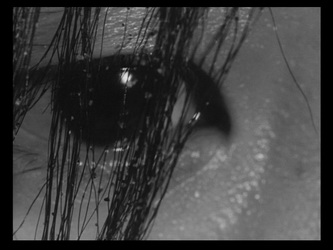 |
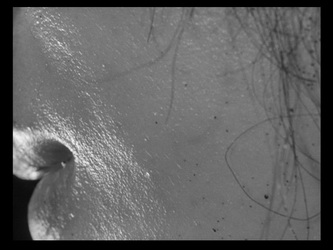 |
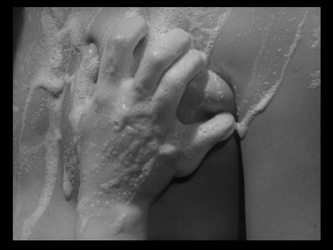 |
|
|
Michelle Greyling
Discuss the use of the extreme close up face shot/body detail shots versus the more typical close up that is also used in the film?
In the beginning of the film "Woman in the Dunes", the character of the sand is revealed by use of an extreme close-up shot. The extreme close-up shot of a sand grain, manipulate the visual perception of scale to the point that the small grain of sand appear monstrous. Such manipulation of scale foreshadow the sand's power over entire villages. Similarly, extreme close-up shots is used throughout the film for body and facial detail shots to portray symbolic meaning or representation. Scale is the primary element that differentiate the extreme close-ups with the typical close-ups. The scale of the extreme close-up shots add rich informative symbolism and representation to the film. The extreme close-up shots of the body and face, express the extent that the sand have saturated the lives of the characters while simultaneously representing the power that the sand has over them.
The Typical close-up shots in the film portray only the result or consequence of the sand on the character by portraying it as "dirt" on the characters rather than an invasive organism. Extreme close-up shots on the contrary, carry deeply embedded symbolism. The sand is depicted as an invasive living organism in the film that infiltrate every part of the main characters life. The close-up shots reinforce this reality by exposing the presence of the sand on the sweaty skin and hair of the characters. Extreme close up shots of the woman where she lies sleeping further emphasize the power of nature over man. Furthermore, an extreme close-up shot of the skin of both the woman and man while they are together, make it impossible to identify either of them emphasize their "oneness".
One of the prominent extreme close-ups in the film, is the shot of the woman's eye. This exaggerated close-up of her eye reveal her "seductive" character while uncovering her true intentions. Her seduction is subtle but the extreme close-up foreshadow her future actions. The woman's hair, that cover her eye in this shot, is full of sand. The ever-present character of the sand is emphasized by this extreme close-up shot to express the degree that the sand have invaded her body. Another symbolic meaning that may be drawn from this extreme close-up of her hair that cover her eye, is one relating to her imprisonment. Her eye is covered with vertical strings of hair that resemble the view outward from a prison cell. This relate perhaps to her own imprisonment and the revelation of who she has become by being imprisoned. The extreme close-up of the woman's eye, when the man tells her that sand removal is a job for a monkey, seem to draw a parallel between man and animal. This extreme close-up of the imprisoned woman's eye is placed in contradiction with an extreme close-up later in the film that depict the crows eye that is representative of freedom.
Another remarkable extreme close-up in the film, is the shot of the woman's hand lathering the man's chest.
This extreme close-up shot is impregnated with deep symbolic meaning. The soap and the act of cleaning represent possible freedom from the sand. The cleansing hand however belong to the woman who is a seducer. While the hand is cleansing the man of the sand that invaded his body, the woman's hand grip the man's chest revealing the woman's intention to capture or trap his heart as well. The woman's hand grip the left hand of the man's chest to emphasize that it is his heart that she craves. The heart is normally portrayed to be on the left side of the body because the left heart or left ventricle is stronger.
In several instances the close-ups of the hair and skin resemble the very insects that the man is studying. This is further emphasized where extreme close-up shots of the man swallowing, portray the skin to be even more insect-like. These extreme close-up shots seem to reveal that the situation of the man and woman is not very different to that of a trapped insect. The Extreme close-up shots of the skin in this film also tend to reinforce the reality of actually touching the skin. These extreme close-up shots enhance the portrayal of human sexuality which become part of life's reality. In fact, in the sand pit the representation of daily life is reduced to the basics of work, sleep, food and sex and the extreme close ups work to reveal the essence of these basic acts of daily life.
http://rogerebert.suntimes.com/apps/pbcs.dll/article?AID=/19980201/REVIEWS08/401010314/1023
http://www.criterion.com/current/posts/593-woman-in-the-dunes-shifting-sands
http://www.theasc.com/clubhouse/films/dunervw.htm
http://en.wikipedia.org/wiki/The_Woman_in_the_Dunes
http://www.imdb.com/title/tt0058625/
|
|
|
13. |
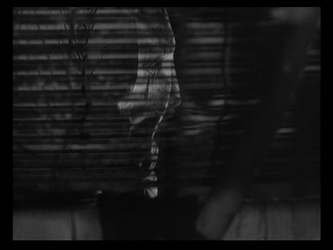 |
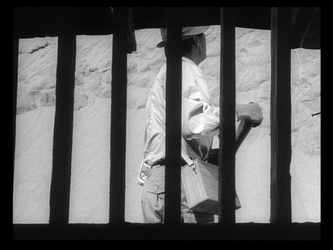 |
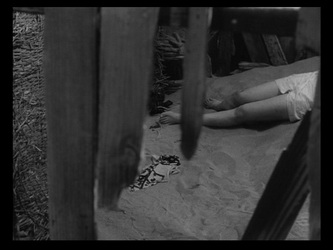 |
|
|
Richard D'Allessandro
Discuss the use of architecture as "screen" through which to view the scene that is being portrayed.
Architecture is used very consciously in this film as a contextual filter through which scenes are constantly framed in light of the chronic circumstance; that of these two character’s imprisonment. The house, slowly sinking in a pit of sand, is the all-encompassing architecture of the film. It is their trapper, their abuser, but also their only life preserver and hope of eking out some meager existence. The house is irony; it is desperation and dependence personified. Filming each scene through the house brings it to life as another character of the film, like an insidious and ambivalent third wheel overseeing the relentless struggle of the others. Framed though the house, the intense irony and extreme tension of the situation never subside, and we are accompanied by it, like the characters, for the entire length of the story. These qualities that the house epitomizes, physically and metaphorically, force us to contemplate the dilemma of the two suffering characters at every scene. Like the arguments of a defense and prosecutor in the context of a court case, as we watch these two through the house, every scene is considered through the contextual lens of a crime committed. In this way, the architecture of the house acts as a screen. Every shot through it preserves our situational awareness, as viewers, and reinforces each scene with the extreme tension of the setting.
Highlighting qualities of the incarcerated, the characteristics of the house invite a direct comparison to an actual prison. Especially in the scenes referenced for this discussion, there is both a figurative and literal looking through gaps in the prison bars. Their prison, like all prisons, implies a fragile and barely adequate living, with but little hope for anything more. They are both confined to the house and the house is sinking. This constant juxtaposition framed by the punitive quality of the house, and the house itself being slowly overcome by sand, is an unrelenting reminder of their life sentence and the impending doom they face in every instant. This comparison is matched by the characters as well; as we see the man and women portray a complementary duo of inmates sharing a cell. One character accepts the harsh reality of their sentence and tries to make the most out of the one shred of life left worth living. For her, the condition of the household is that last remnant or representation of an ideal. And the other cannot accept, feeling wrongly sentenced furthermore, he is determined to break out. His bitter frustration has rendered the house as an oppressive obstacle to overcome.
The way we view these scenes through the familiar architecture of the house, also reveals an obvious domestic dynamic. As such, the film presents the story through the house as a faithful allegory for our own societal crisis. Consider especially, the remarkably parallel lifestyle of a typical modest-income couple living in a small house. Between bills and the maintenance of the house itself, it is too both their slaver and yet the only thing protecting them from the weather and the penalties of absolute homelessness. The careful filming of this bizarre fiction through a household portrays the eerie extremes of this dilemma. The film maker uses heartfelt architectural associations as a device to confront the household archetype with an impact resonating deep in the minds of the audience. We must acknowledge that, whether slowly sinking into to sand or being slowly enveloped by debt, the fundaments and feelings are the same. In this fiction and in our own lives, we are forced into these conditions by a certain form of coercion, and then conditioned until our will is broken and we come to accept our new ill-fated existence.
|
|
|
14. |
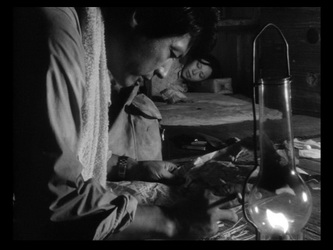 |
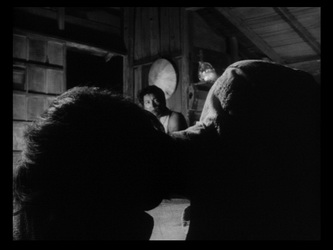 |
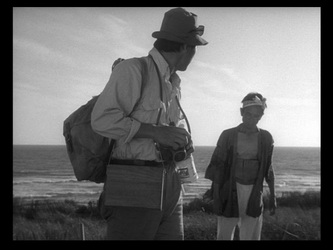 |
|
|
Talayeh Hamidya
Discuss the use of depth of field as a device in the creation of the film. Include information about image blur and the placement of the characters in the scene, as they relate to the architectural setting. Is this carried out the same for interior versus exterior settings? How does it speak to point of view (of the characters in the scene vs we the audience)?
In the interior shots there's an emphasis on the surfaces. Close shots of the materiality and textures. Often scenes like close shot of the canvas curtain, the skin, or sand create a moment of pondering and slowness that facilitates communication of intimate moments. Emotions are subdued but expressed visually with investigation of details and feels of the objects in the house. Blurring is used to introduce a new chapter, relationship or situation between the mini events that happen in the course of the movie. TO create an effect of a fantastical or dream-like event blurring and unusual short depth of field are used. The seemingly unrelated incidents in the house are attached together to create an illusion of existence. In the exterior shots however, the depth of field is larger and stretched from a smaller foreground to a vast background, with placement of the character to create tension in the composition of the scene. Very often the characters are closer to the corner of the image or are half hidden by the foreground layer. This happens usually with the use of sand dunes. Repetition and banality are expressed in and around sands. The moment of tense conversations between the man and the woman or the man escaping is filled with sand and the futility of the man's imagination of a free world is depicted with placing him alone among the dunes. At many occasions we (audience) are forced to look at the situation from above, literally and emotionally, while the characters are evidently in tension between themselves and with their environment. The vertical point of view gives distances the audience and prevents continuous involvement of the audience emotions with the characters. But at the same time solidifies the loneliness and separation of the couple from what is known the outside world to them. Towards the end of the film there are more occasions of the character against the vast nature, facing the camera, at the center of the image. Freedom is expressed with solitude and satisfaction.
|
|
|
15. |
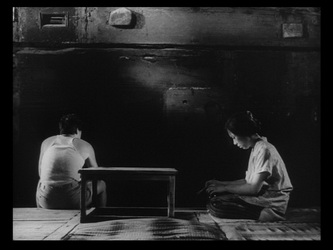 |
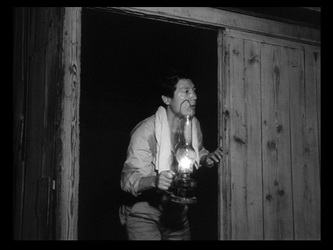 |
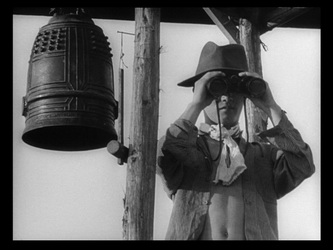 |
|
|
Maryam Abedini Rad
Many scenes in the film take on a theatrical appearance or setting very similar to those used in plays. How does this impact the film - particularly how these scenes contrast with the larger naturescapes of desert that are used in juxtaposition?
The Woman in the Dunes "Suna no onna", literally "Sand woman," also translated as The Woman of the Dunes is a film directed by Hiroshi Teshigahara and based on the novel of the same name by Kobo Abe. The novel was published in 1962, and the film was released in 1964. Kobo Abe also wrote the screenplay for the film version.
The surreal and, at times, absurd nature of The Woman in the Dunes has been compared to existentialist works. Aside from its intriguing premise, this film is notable for the life that Teshigahara brings to the ever-shifting sand, which almost becomes a character in its own right.
Being that the film is essentially a two person show; the performances of Eiji Okada and Kyoko Kishida (two lead characters) are truly exemplary. Throughout the film’s almost two-and-a-half hour runtime they maintain a magnetic hold on the audience. Whether the script requires wonder, anger, lust, animosity, fear, or contemplation, these two give it their all. There are no false notes to take the viewer out of the experience, no self conscious acts to detract from their realism. They are the book’s characters manifest. Thus, watching them is a somewhat a joyous, frightening, and thrilling experience, and sometimes a mixture of all three. Many scenes in the film take on a theatrical appearance or setting very similar to those used in plays (specially the interior scenes in the cottage).
The home Teshigahara builds for the film viewer is an ever shifting reality that is simultaneously both breathtakingly beautiful and horrific. For this couple not only must live in a world in which no values are permanent, but endure an ever changing landscape that reminds them every moment of their own mortality.
In an early shot, Jumpei and the Woman share a dinner inside her cottage. Though the background is in as perfect focus as the characters in the foreground, it is barely lit. Teshigahara further underscores the claustrophobia of the shot by slowly zooming in on the couple until they’re in a medium two-shot. This shot, as well as a few other scenes, suggests a more technically sophisticated variation Teshigahara favors long takes, with many shots lasting a minute or more, and in these very long-in-duration shots one can feel the camera pressing down on the leads.
These kinds of interior shots with limited vision for the viewers and especially when just two actors perform in it, makes us remember theatrical actions in plays. Because like the theatre and plays one can focus in the actors' actions and the limited scene which is decorated as a background.
It those scenes which the lady is lied down naked, it is important to distinguish here between a ‘biological’ body and a ‘performative’ body — a so-called ‘essential’ physiognomy determining gender versus a theatrical physiognomy that is determined by performance. Perhaps this is indeed the defining feature of the theatrical: to be able to create (symbolically) a particular ‘essence’ through bodily expression.
Throughout the film, sand is also treated in a way resembling water. Teshigahara interrupts the narrative action with shots of sand represented in waves, streams, and cascades. Such images evoke freedom and fluidity. The cascading, curving, sweeping lines “visually represent the desired escape from limits,” a material embodiment of both "freedom and fluid movement.”
Woman in the Dunes is a film that cinematography and nature combine as powerful forces of artistic expression, melded with a timeless story of the human condition. Dialogue is sparse and precise, submitting to dreamlike atmosphere and imagery that is genuinely universal; this is the cinematic equivalent of a prehistoric cave drawing, telling a story for all humankind.
The cinematographer was Hiroshi Segawa, and he played with light and shadow like a painter, finding a perfectly balanced blend between Abe's prose and Teshigahara's vision. He helped Sand become the third major character in the film, giving it personality, creating a Dali-esque canvas. He photographed sand as if it were a breathing beast, with wind rippling over the white dunes spreading the sand like waves of water, flapping the edges like it was moving silk. And he utilized a lot of extreme close-ups of skin pores choked with grains of sand and sweaty strands of hair with sand granules clinging to them. In fact, the landscape shots which are done very carefully and beautifully are an emphasis on the narrative and the reflex of the woman`s body who is a part of this beautiful cruel nature.
All in all, I personally think that the landscaping scenes and the interior theatrical scenes have made fascinating combination and strong correlation as we see for example in the scene that the sand that rests in the ‘dunes’ of the naked body’s folds and creases”. In this one scene, all of these things are quite literally the case: as we cross-fade between the sand dunes and the sweat body of the woman, they merge into one. Lingering shots of the woman’s thighs, stomach and breasts show that she is just as much a part of the landscape as the rest of the village, and to be seduced and trapped by her is to be consumed by the environment.
http://www.dreamlogic.net/archives/woman-in-the-dunes-dvd-review-criterions-three-films-of-hiroshi-teshigahara
http://en.wikipedia.org/wiki/Woman_in_the_dunes
http://www.amazon.com/Woman-Dunes-Eiji-Okada/dp/B00003G4JA
http://www.amazon.com/Suna-onna-Woman-Dunes-VHS/dp/6303593410
|
|
| |
16. |
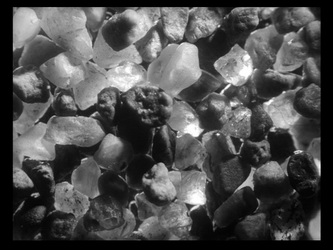 |
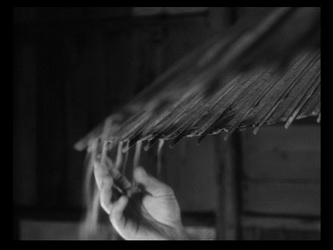 |
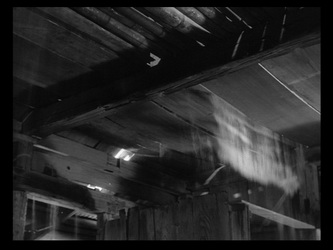 |
|
|
Jamie Usas
Sand could be deemed a "character" in this film. Discuss the cinematic devices used to create the changing character and importance of sand in the film.
Hiroshi Teshigahara’s Woman in the Dunes is an existential parable focusing around the seemingly meaningless struggle of day-to-day life. The characters of the film are absorbed in a world of endless sand; sand that penetrates every inch, orifice and facet of their being, sand that cannot be overcome but merely managed. Sand defines the world of the characters in an endless struggle between perseverance and frustration. The sand, a character in it’s own right, is experienced cinematically at multiple scales, emanating the multiple characteristics of the sand itself. Confronting the sand gives purpose to the lives of the villagers, while taunting them with the futility of the confrontation. The sand is first seen at a macro scale, individual grains magnified like extraterrestrial joules filling the frame. The viewer then observes a series of edits that rapidly reduce the scale of the sand to the incomprehensible vastness of the desert. Cinematically, the sand is juxtaposed against the ocean, drawing unconscious comparisons to the to the extremes of the wet and dry. For the man and the woman, that sand at once draws them together and pulls them apart. It is while brushing the sand from there bodies that the two first express their physical attraction in erotic action, and inversely in an effort to escape the sand that the two are engaged in a degrading violent sexual performance to amuse the villagers.
|
|
| |
|
|
|
|
|
| |
|
|
|
|
|
